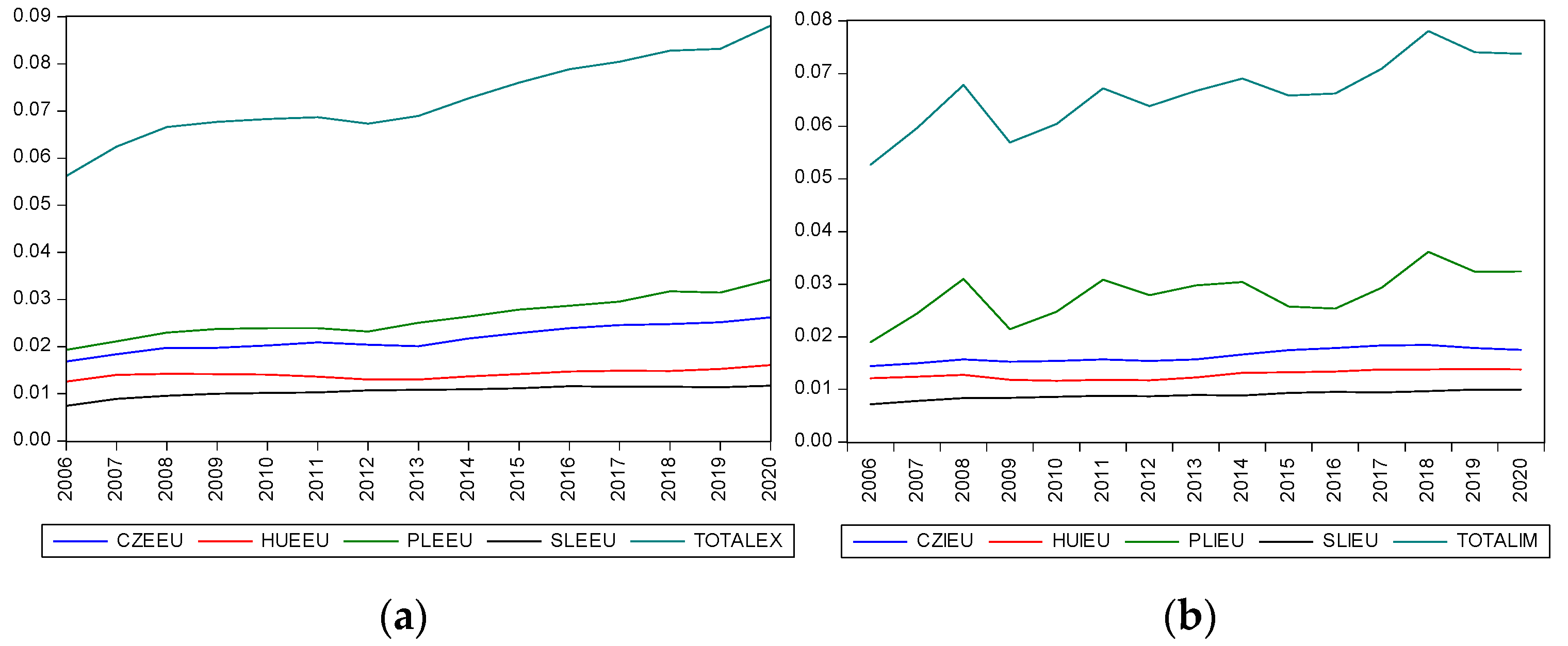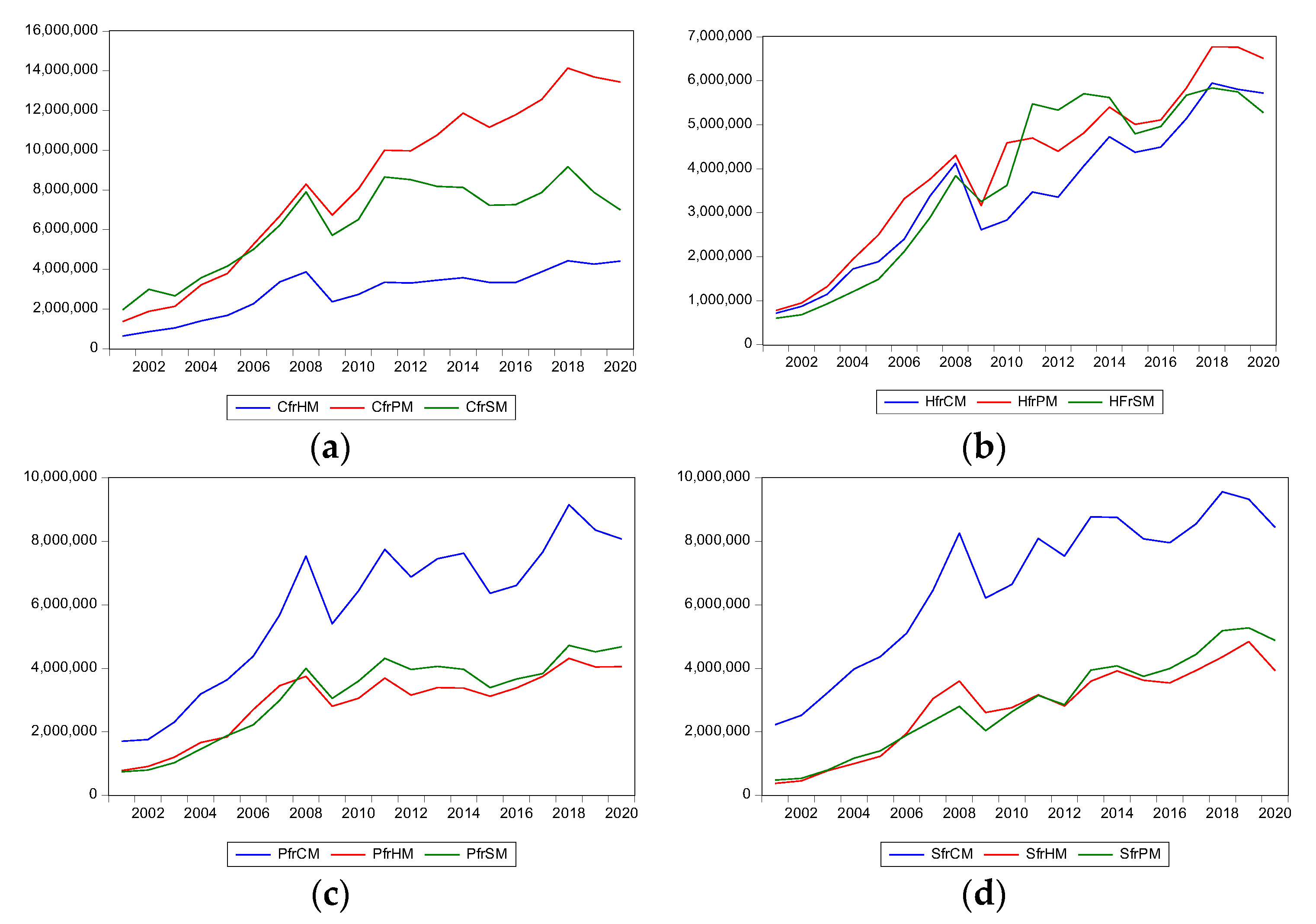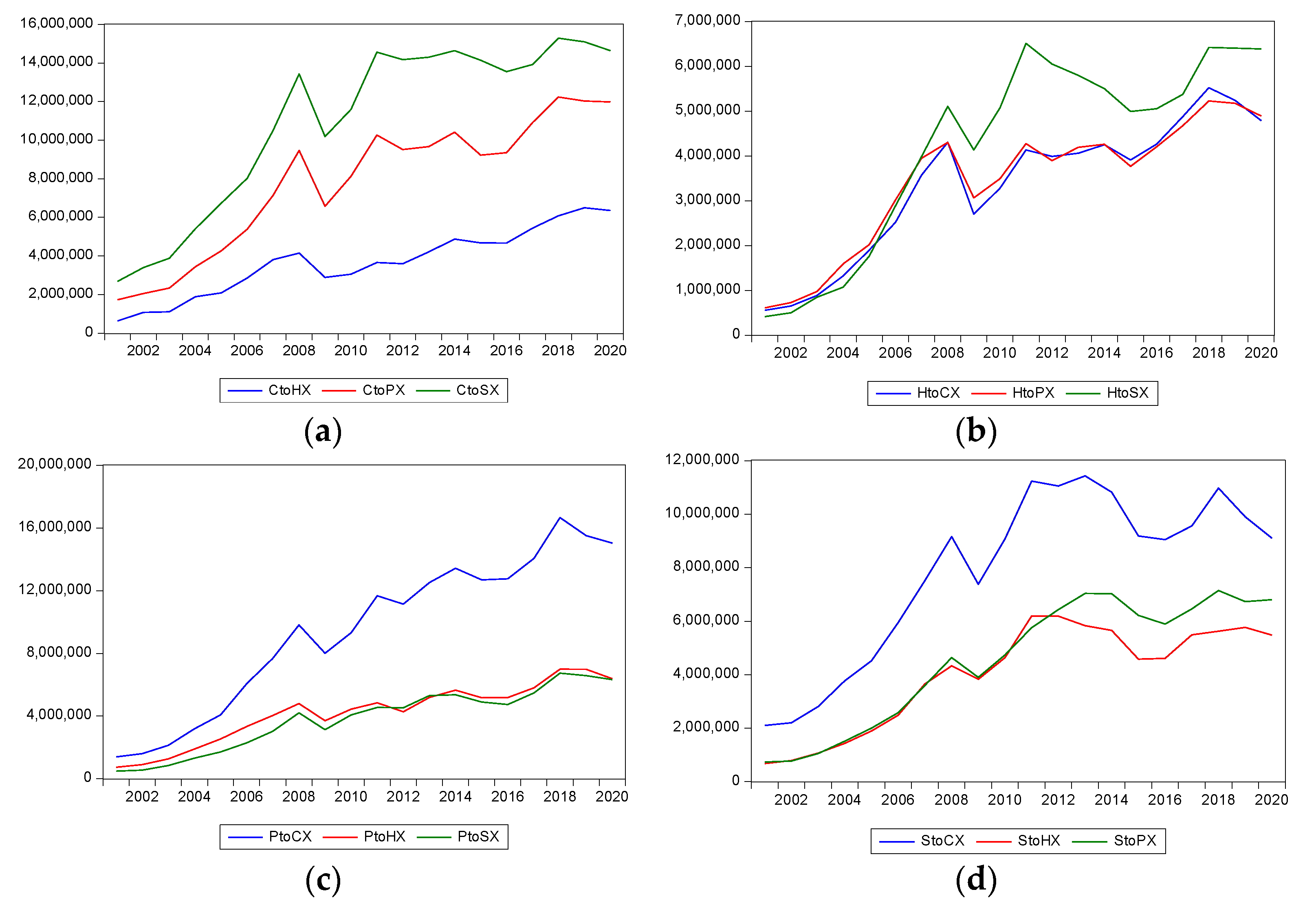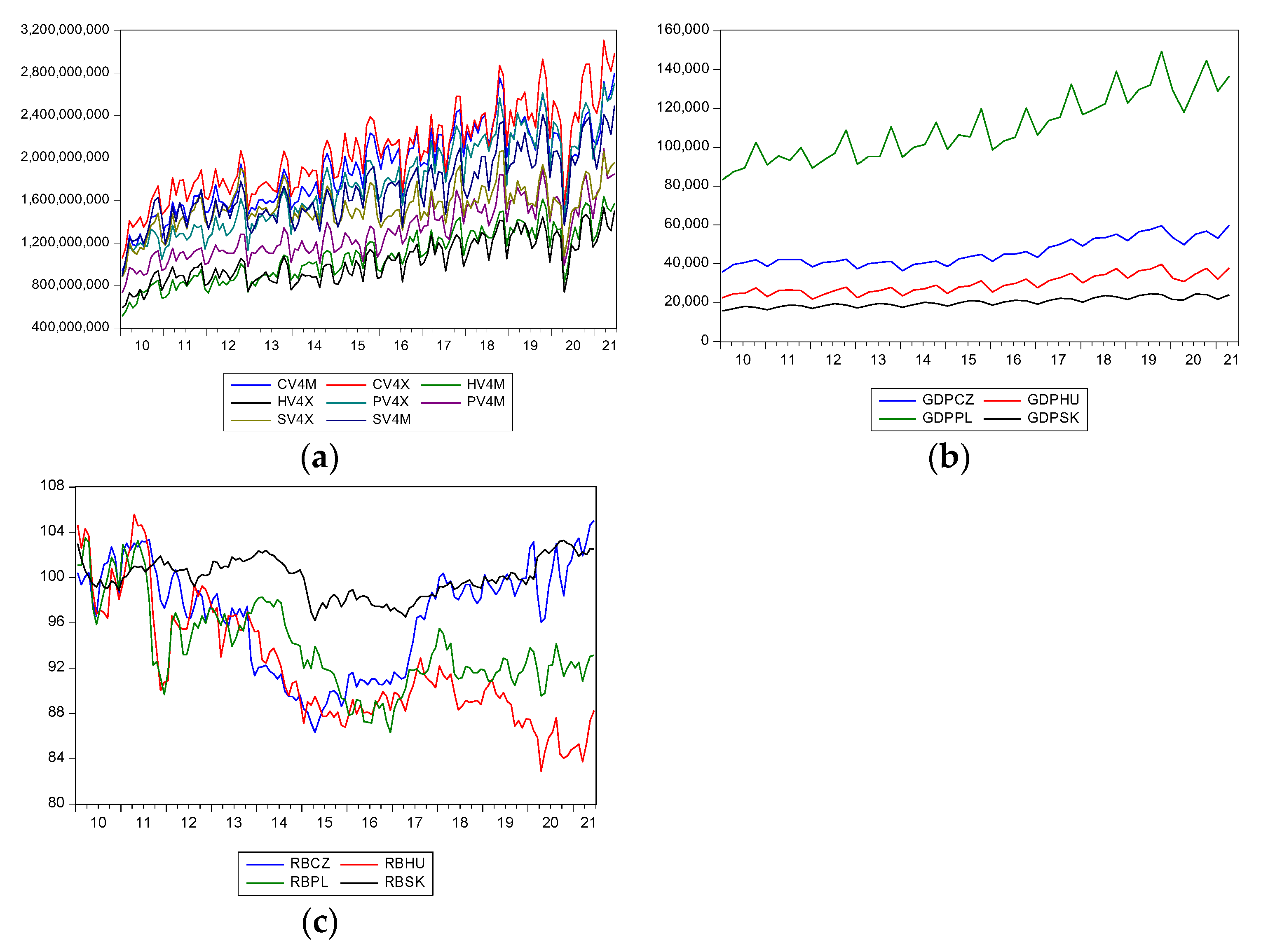You're using an outdated browser. Please upgrade to a modern browser for the best experience.
Please note this is an old version of this entry, which may differ significantly from the current revision.
Subjects:
Economics
The impact of the COVID-19 pandemic has been detrimental to all countries, despite the continuous efforts of governments on all continents to attempt to mitigate its damaging effects. All economic and social indicators have worsened. COVID-19 impact was evident in all countries, but not with the same strength.
- COVID-19
- international trade
- Visegrad Countriesimport
- export
- lockdowns
- real exchane rate
- GDP
1. International Trade in the V4
The set of papers published by Smutka et al. (2012b; Svatoš et al. 2010; Vološin et al. 2011) analyzed trade with agricultural commodities and explored the territorial structure and competitiveness of the agricultural trade of the Visegrad Group in 1993–2008. The authors found that there has been a significant increase in the volume and value of traded agricultural products. The territorial structure of exports and imports has concentrated on the trade with the countries of the EU27. Their accession to the EU in 2004 was favourably reflected in the agricultural trade results, especially in the case of Poland. Nevertheless, even in the case of the Czech Republic and Slovakia, the accession did not impair the results in the area of agricultural trade. Serious structural problems in the agricultural sector after EU accession occurred only in Hungary. Nevertheless, it can be argued that these problems could be attributed to Hungary’s current economic problems.
Babunek (2012) investigated the inflow of foreign direct investment per capita in the countries of the Visegrad Four and their most important trading partners using analyses of variance (ANOVA). He found significant differences between the countries. However, after including Germany and Austria, he found that these countries form a compact unit in terms of FDI per capita. Richter (2012) analyzed the changes in trade between the V4 after the group entered the EU based on SITC commodity groups. He established that there was an aggregate upturn in the mutual trade of the region’s countries; intra-Visegrad trade has risen. However, the commodities structure has not changed significantly. The author identified the important role of foreign-owned enterprises in the V4 countries, and he attributed the rise to their presence. The paper shows that the EU accession has not brought about many abrupt changes in commodity patterns. Furthermore, the effect is not focused on the year of accession but is more or less spread over the period before the accession. The Visegrad region is thought to have been upgraded both as a target for sales and a producer having a host of potential cooperation production partners.
Ugurlu and Jindrichovska (2019) tested the gravity models using trade variables and FDIs, as well as the impact of local culture represented by the gradual acceptance of IFRS. The gravity model was significant in the Czech Republic. Furthermore, Kowalska et al. (2021) explored the competitive position of the V4 in the agri-food segment focusing on the international competitive position of the V4 countries. The V4 countries’ accession to the EU significantly changed the exporters’ and importers’ situation in these countries, providing them with better access to numerous markets. The authors conclude that Poland performed the best in international trade in agri-food products among the V4 countries. Similar results were also confirmed in relation to the Czech Republic (2018).
2. Impact of COVID-19
Based on the International Monetary Fund (IMF) (2021) data, the first case of COVID-19 was reported on 1 March 2020 in Czech Republic, 4 March 2020 in Hungary and Poland, and 6 March in Slovakia. Many papers investigate the impact of COVID-19 on trade (Cvik and MacGregor Pelikánová 2021; Jindřichovská and Uğurlu 2021) and consumption (MacGregor Pelikánová and Hála 2021).
Czech et al. (2020) explored the short-term reaction of the financial markets of the V4 to the COVID-19 pandemic. The authors have used the exchange rates of local currencies to EUR on the major stock markets Prague PX, Budapest BUX, Warsaw WIG20, and Bratislava SAX. Exploration of exchange rates indicated that, in the long term, a large depreciation of the Czech koruna (CZK), Hungarian forint (HUF), and Polish zloty (PLN) was expected rather than a significant appreciation. The authors also show that there is a high correlation between reported cases and the depreciation of their exchange rates, implying that the ongoing pandemic has resulted in the depreciation of the Visegrad currencies. Furthermore, the result of the TGARCH model shows a significant negative link between the Visegrad stock market indices and the spread of COVID-19. The authors imply that the V4 countries are currently expected to be on the verge of the deepest recession they have experienced since their transition to market-oriented economies in the 1990s. Salamaga (2021) investigated FDI accumulation during the coronavirus crisis using correspondence analysis. The author finds that Hungary and the Czech Republic have experienced a great reduction in FDI accumulation compared to the other two countries. Lacka et al. (2020) investigated the trade and GDP of the V4 countries for the 1996–2018 period. The authors state that, in 2018, Slovakia was the weakest export economy in the V4. Moreover, in 2018, Germany was the main export and import country of the V4 countries. The author used a VEC model and Granger causality test and concluded that there is no long-term interdependence of the countries in the context of international trade and growth.
Astrov and Holzner (2021) presented comprehensive information on the effect of COVID-19 on the V4 countries. The Czech Republic has the largest number of cases and deaths per capita among the V4 countries, and Slovakia has the lowest. The authors investigate the EU transfers to the V4 countries and state that Poland has had the biggest transfer, followed by the Czech Republic, Hungary, and Slovakia. The volume of transfers was EUR 29.6bn, EUR 8.6bn, EUR 6.4bn, and EUR 6.3bn, respectively.
In a broader context, Hayakawa and Mukunoki (2021) investigated the impact of COVID-19 on global value chains using the export value of finished machinery products as a dependent variable to show the trade data and GDP of the investigated countries, and some dummy variables, such as regional trade agreement and COVID-19 dummies. Erokhin and Gao (2020) focused on the effect on food trade using the balance of food trade to measure trade. The authors use the number of confirmed COVID-19 cases to show the overall impact of the pandemic. Espitia et al. (2021) offered another paper that investigates the pandemic’s effect, using a data period that starts from June 2020 as a beginning of the pandemic.
3. Trade among V4 Countries
International trade in the V4 consists of mutual import and export flows between the countries; however, it is strongly influenced by the dominant trading block—the EU—which sets the rules and provides regulations for all countries.
To compare the magnitude of trade flows: based on the Trademap data, the proportion of the imports of V4 countries in the total EU imports (exports)ranges between 1 and 3 per cent, and their total proportion in EU imports (exports) is about 6 per cent on average (see Figure 1).However, because of the global world trade decrease, in relative prices, during the COVID-19 period, both the numerator (the country trade) and the denominator (EU trade) decreased, and the change of their ratio is less than their absolute change. Therefore, to see this effect clearly, working with absolute data will give better results.

Figure 1. (a) Export Variables, (b) Import Variables. Trade ratio of V4 members. CZEEU: the Czech Republic’s exports to Europe/Europe’s exports to the world, HUEEU: Hungary’s exports to Europe/Europe’s exports to theworld, PLEEU: Poland’s exports to Europe/Europe’s exports to the world, SLEEU: Slovakia’s exports to Europe/Europe’s exports to the world, TOTALIM = CZEEU + HUEEU + PLEEU + LEEEU, CZIEU: the Czech Republic’s imports from Europe/Europe’s imports from the world, HUIEU: Hungary’s imports from Europe/Europe’s imports from the world, PLIEU: Poland’s imports from Europe/Europe’s imports from the world, SLIEU: Slovakia’s imports from Europe/Europe’s imports from the world, TOTALEX = CZIEEU + HUIEU + PLIEU + LEIEU.
Figure 2 shows the countries’ bilateral trade with the other V4 countries and the sum of the three countries, which is named “tot”. CfrHM is a Czech Republic import from Hungary, CfrPM is a Czech Republic import from Poland, and CfrSM is a Czech Republic import from Slovakia. In these graphs, the right-hand axis shows total data while the left-hand axis shows individual countries. The other variables are named with the same logic. Among the V4 countries, the main import partner of the Czech Republic is Poland, the second is Slovakia, and the third is Hungary. For Hungary, the other three partners’ import value is slightly closer. For Slovakia and Poland, the Czech Republic is the main import partner, and the other two countries have very close values. For all the countries, it can be seen a decrease after 2019.

Figure 2. Imports of the countries from the other V4 members: (a) Czech Republic; (b) Hungary; (c) Poland; (d) Slovakia.
Figure 3 shows the countries’ bilateral trade with other V4 countries. The sum of the three countries is abbreviated as “tot”. CtoHX is a Czech export to Hungary, CtoPX is a Czech export to Poland, and CtoSX is a Czech export to Slovakia. The right-hand axis in these graphs shows the total data, and the left-hand axis shows individual countries. The other variables are named using the same logic. The Czech Republic’s main export partner is Slovakia. Hungary has significantly lower values than the other three countries. For Hungary, the major export partner is Slovakia; for Poland and Slovakia, the major export partner is the Czech Republic. For Hungary, Poland, and Slovakia’s export partners, the second and third partners have very close values.

Figure 3. Exports of the countries from the other V4 members: (a) Czech Republic; (b) Hungary; (c) Poland; (d) Slovakia.
International trade in the V4 consists of mutual import and export flows between the countries; however, it is strongly influenced by the dominant trading block—the EU—which sets the rules and provides regulations for all countries. Figure 4 shows imports, exports, GDP, and real exchange rates of the V4 countries.
 Figure 4.Development of imports, exports, GDP, and real exchange rates of the V4 countries from 2010 to 2021.(a) Imports and exports; (b) GDP; (c) real exchange rates.
Figure 4.Development of imports, exports, GDP, and real exchange rates of the V4 countries from 2010 to 2021.(a) Imports and exports; (b) GDP; (c) real exchange rates.
This entry is adapted from the peer-reviewed paper 10.3390/jrfm15020041
References
- Svatoš, Miroslav, and Lubos Smutka. 2010. Development of agricultural foreign trade in the countries of Central Europe. Agricultural Economics 56: 163–75.
- Svatoš, Miroslav, and Lubos Smutka. 2012a. Development of agricultural trade and competitiveness of the commodity structures of individual countries of the Visegrad Group. Agricultural Economics 58: 222–38.
- Bahmani-Oskooee, Mohsen, and Margaret Malixi. 1992. More evidence on the J curve from LDCs. Journal of Policy Modeling 14: 641–53.
- Ugurlu, Erginbay, and Irena Jindrichovska. 2019. Estimating gravity model in the Czech Republic: An empirical study of impact of IFRS on Czech international trade. European Research Studies Journal 22: 265–81.
- Kowalska, Anna, Klaudia Gurkowa, Anna Olszańka, Ivan Soukal, and Martin Matejicek. 2021. Assessment of the Competitive Position of the V4 Group Countries in the Foreign Trade of Agri-food Industry Products. In Proceedings of the International Scientific Conference Hradec Economic Days 2021. Edited by Maci Jan. Hradec Kralove: University of Hradec Kralove, vol. 11, pp. 449–70. ISBN 9788074358227.
- Svatoš, Miroslav, and Lubos Smutka. 2012b. Development of agricultural trade of Visegrad group countries in relation to EU and third countries. AGRIS Online Papers in Economics and Informatics 4: 55–69.
- International Monetary Fund (IMF). 2021. Policy Responses to COVID-19. Available online: https://www.imf.org/en/Topics/imf-and-covid19/Policy-Responsesto-COVID-19 (accessed on 19 November 2021).
- Cvik, Eva Daniela, and Radka MacGregor Pelikánová. 2021. The significance of CSR during COVID-19 Pandemic in the Luxury Fashion Industry—A Front-Line Case Study. European Journal of Business Science and Technology 7: 109–29.
- Jindřichovská, Irena, and Erginbay Uğurlu. 2021. EU and China trends in trade in challenging times. Journal of Risk and Financial Management 14: 71.
- MacGregor Pelikánová, Radka, and Martin Hála. 2021. CSR Unconscious Consumption by Generation Z in the COVID-19 era—Responsible Hereticsnot Paying CSR Bonus? Journal of Risk and Financial Management 14: 390.
- Czech, Katarzyna, Michael Wielechowski, Pavel Kotyza, Irena Benešová, and Adriana Laputková. 2020. Shaking stability: COVID-19 impact on the Visegrad Group countries’ financial markets. Sustainability 12: 6282.
- Salamaga, Marcin. 2021. The use of Correspondence Analysis in the study of Foreign Divestment in the Visegrad Countries during the Coronavirus Crisis. Econometrics 25: 15–26.
- Lacka, Irena, Janusz Myszczyszyn, Sylwia Golab, Beata Bedzik, and Blazej Supron. 2020. Correlation between the Level of Economic Growth and foreign trade: The Case of the V4 Countries. European Research Studies Journal XXIII: 657–78.
- Astrov, Vasily, and Mario Holzner. 2021. The Visegrad Countries: Coronavirus Pandemic, EU Transfers, and Their Impact on Austria, Policy Notes and Reports, No. 43. Vienna: The Vienna Institute for International Economic Studies.
- Hayakawa, Kazunobu, and Hiroshi Mukunoki. 2021. Impacts of COVID-19 on Global Value Chains. The Developing Economies 59: 154–77.
- Erokhin, Vasilii, and Tianming Gao. 2020. Impacts of COVID-19 on Trade and Economic Aspects of Food Security: Evidence from 45 Developing Countries. International Journal of Environmental Research and Public Health 17: 5775.
- Espitia, Alvaro, Aaditya Mattoo, Nadia Rocha, Michele Ruta, and Deborah Winkler. 2021. Pandemic trade: COVID-19, remote work and global value chains. The World Economy, 1–29.
- Lacka, Irena, Janusz Myszczyszyn, Sylwia Golab, Beata Bedzik, and Blazej Supron. 2020. Correlation between the Level of Economic Growth and foreign trade: The Case of the V4 Countries. European Research Studies Journal XXIII: 657–78.
- Astrov, Vasily, and Mario Holzner. 2021. The Visegrad Countries: Coronavirus Pandemic, EU Transfers, and Their Impact on Austria, Policy Notes and Reports, No. 43. Vienna: The Vienna Institute for International Economic Studies.
- Hayakawa, Kazunobu, and Hiroshi Mukunoki. 2021. Impacts of COVID-19 on Global Value Chains. The Developing Economies 59: 154–77.
- Erokhin, Vasilii, and Tianming Gao. 2020. Impacts of COVID-19 on Trade and Economic Aspects of Food Security: Evidence from 45 Developing Countries. International Journal of Environmental Research and Public Health 17: 5775.
- Espitia, Alvaro, Aaditya Mattoo, Nadia Rocha, Michele Ruta, and Deborah Winkler. 2021. Pandemic trade: COVID-19, remote work and global value chains. The World Economy, 1–29.
- Bahmani-Oskooee, Mohsen, and Margaret Malixi. 1992. More evidence on the J curve from LDCs. Journal of Policy Modeling 14: 641–53.
- Ugurlu, Erginbay, and Irena Jindrichovska. 2019. Estimating gravity model in the Czech Republic: An empirical study of impact of IFRS on Czech international trade. European Research Studies Journal 22: 265–81.
- Kowalska, Anna, Klaudia Gurkowa, Anna Olszańka, Ivan Soukal, and Martin Matejicek. 2021. Assessment of the Competitive Position of the V4 Group Countries in the Foreign Trade of Agri-food Industry Products. In Proceedings of the International Scientific Conference Hradec Economic Days 2021. Edited by Maci Jan. Hradec Kralove: University of Hradec Kralove, vol. 11, pp. 449–70. ISBN 9788074358227.
- Cvik, Eva Daniela, and Radka MacGregor Pelikánová. 2021. The significance of CSR during COVID-19 Pandemic in the Luxury Fashion Industry—A Front-Line Case Study. European Journal of Business Science and Technology 7: 109–29.
- Jindřichovská, Irena, and Erginbay Uğurlu. 2021. EU and China trends in trade in challenging times. Journal of Risk and Financial Management 14: 71.
- MacGregor Pelikánová, Radka, and Martin Hála. 2021. CSR Unconscious Consumption by Generation Z in the COVID-19 era—Responsible Hereticsnot Paying CSR Bonus? Journal of Risk and Financial Management 14: 390.
- Czech, Katarzyna, Michael Wielechowski, Pavel Kotyza, Irena Benešová, and Adriana Laputková. 2020. Shaking stability: COVID-19 impact on the Visegrad Group countries’ financial markets. Sustainability 12: 6282.
- Salamaga, Marcin. 2021. The use of Correspondence Analysis in the study of Foreign Divestment in the Visegrad Countries during the Coronavirus Crisis. Econometrics 25: 15–26.
- Lacka, Irena, Janusz Myszczyszyn, Sylwia Golab, Beata Bedzik, and Blazej Supron. 2020. Correlation between the Level of Economic Growth and foreign trade: The Case of the V4 Countries. European Research Studies Journal XXIII: 657–78.
- Astrov, Vasily, and Mario Holzner. 2021. The Visegrad Countries: Coronavirus Pandemic, EU Transfers, and Their Impact on Austria, Policy Notes and Reports, No. 43. Vienna: The Vienna Institute for International Economic Studies.
- Hayakawa, Kazunobu, and Hiroshi Mukunoki. 2021. Impacts of COVID-19 on Global Value Chains. The Developing Economies 59: 154–77.
- Erokhin, Vasilii, and Tianming Gao. 2020. Impacts of COVID-19 on Trade and Economic Aspects of Food Security: Evidence from 45 Developing Countries. International Journal of Environmental Research and Public Health 17: 5775.
- Espitia, Alvaro, Aaditya Mattoo, Nadia Rocha, Michele Ruta, and Deborah Winkler. 2021. Pandemic trade: COVID-19, remote work and global value chains. The World Economy, 1–29.
This entry is offline, you can click here to edit this entry!
